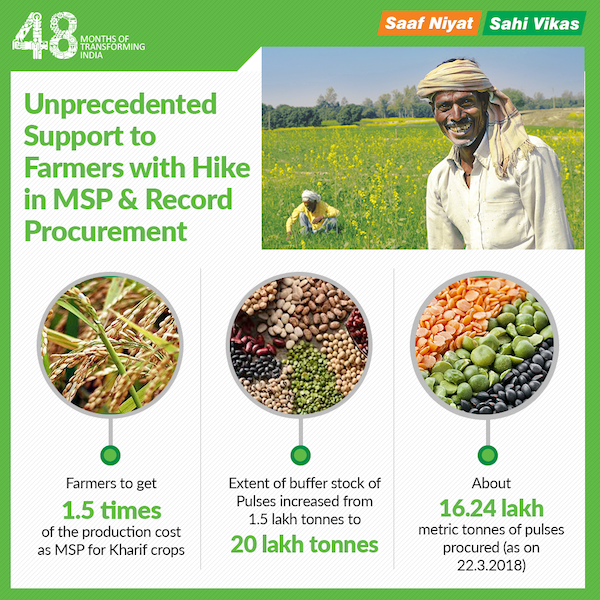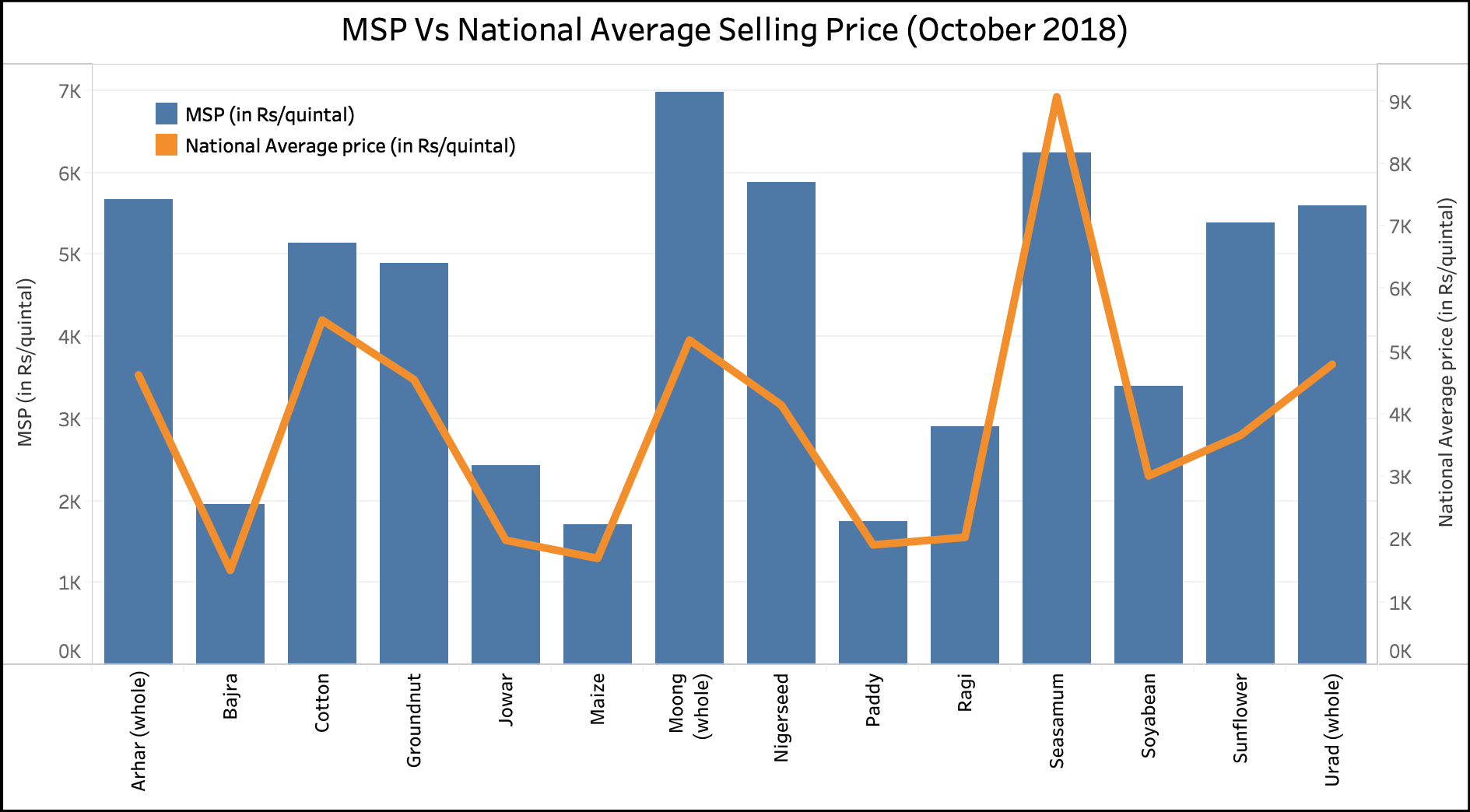[orc]The government published an infographic on the 48-months portal making three claims about hike in MSP and procurement. This article is a fact check of the claims.
The government published an infographic on the 48-months portal making three claims about hike in MSP and procurement. This article is a fact check of the claims.

What is the Food Corporation of India?
The Food Corporation of India (FCI) was setup under the Food Corporation’s Act 1964 , in order to fulfill following objectives of the Food Policy;
- Effective price support operations for safeguarding the interests of the farmers
- Distribution of food grains throughout the country for public distribution system
- Maintaining satisfactory level of operational and buffer stocks of food grains to ensure National Food Security
Since its inception, FCI has played a significant role in procurement, storage & distribution of food grains.
Are farmers getting 1.5 times the production cost as MSP?
The first claim is that ‘farmers to get 1.5 times of the production cost as MSP for Kharif crops’.
According to the FCI website, ‘the Government policy of procurement of Food grains has broad objectives of ensuring MSP to the farmers and availability of food grains to the weaker sections at affordable prices. It also ensures effective market intervention thereby keeping the prices under check and also adding to the overall food security of the country. FCI, the nodal central agency of Government of India, along with other State Agencies undertakes procurement of wheat and paddy under price support scheme. Coarse grains are procured by State Government Agencies for Central Pool as per the direction issued by Government of India on time to time. The procurement under Price Support is taken up mainly to ensure remunerative prices to the farmers for their produce which works as an incentive for achieving better production. Before the harvest during each Rabi / Kharif Crop season, the Government of India announces the minimum support prices (MSP) for procurement on the basis of the recommendation of the Commission of Agricultural Costs and Prices (CACP) which along with other factors, takes into consideration the cost of various agricultural inputs and the reasonable margin for the farmers for their produce.’
As per the government’s response in Lok Sabha in December 2018, ‘government generally increases the MSPs of all notified crops which provide adequate return over cost of production. Government has increased MSPs substantially for all mandated crops for the season 2018-19. This decision of the Government was a historic one as it fulfills the commitment to the farmers to provide 50 per cent return over cost of production for the first time for all mandated crops.’
While it is true that the MSP offered by the government is 50% more the cost as determined by the CACP for 2018-19, this also happened multiple times during the UPA if one goes by the CACP reports. However, various farmer organizations have demanded that the 50% be over the ‘C2’ cost and not over the ‘A2+FL’ cost.
What is MSP?
The Commission for Agricultural Costs & Prices (CACP) since 1985, earlier named as Agricultural Prices Commission) came into existence in January 1965. The 2017-18 annual report of the Ministry of Agriculture and Farmers Welfare states that, ‘CACP was set up with a view to evolve a balanced and integrated price structure, and is mandated to advise on the price policy (MSP) of 23 crops. These include seven cereal crops (paddy, wheat, jowar, bajra, maize, ragi and barley), five pulse crops (gram, tur, moong, urad and lentil), seven oilseeds (groundnut, sunflower seed, soybean, rapeseed-mustard, safflower, nigerseed and sesamum), copra (dried coconut), cotton, raw jute and sugarcane.’
In order to understand the MSP better, it is important to know the determinants of it. The same annual report also states that, ‘Cost of production (CoP) is one of the important factors in the determination of MSP of mandated crops. Besides cost, the Commission considers other important factors such as demand and supply, price trends in the domestic and international markets, intercrop price parity and terms of trade between agricultural and non-agricultural sectors, the likely impact of MSPs on consumers, in addition to ensuring rational utilization of land, water and other production resources.’ Thus, pricing policy i.e. the exercise of MSP is not based on cost only though cost is an important determinant of MSP. To understand more about what MSP is and its constituents, watch Factly’s explainer video on MSP.
In whose tenure did MSP increase the most?
While 50% MSP over the cost was offered both during the UPA & the NDA, it is important to understand the quantum of MSP increase in their respective tenures.
The Directorate of Economics and Statistics & Reserve Bank of India’s handbook of statistics have data related to the MSP of various crops over the years. The Open Government Data (OGD) platform of the government also has the MSP for the years between 2003 and 2012.
It can be seen from the data that the MSP for wheat did increase from Rs. 640 per quintal in 2004-05 to Rs.1285 per quintal in 2011-12. By the end of UPA’s second term in 2013-14, the MSP for wheat was Rs. 1400 per quintal. During the current government, the MSP for wheat increased from Rs.1450 per quintal in 2014-15 to Rs. 1840 per quintal in 2018-19.
In the case of paddy, MSP in 2003-04 was Rs. 550 and it increased to Rs. 1080 in 2011-12. The MSP for Paddy increased to Rs. 1310 per quintal by the end of UPA’s term. In the of the current government, the MSP for paddy increased from Rs. 1360 per quintal in 2014-15 to Rs. 1750 per quintal in 2018-19. It has to be noted that these prices correspond to Paddy (Common) and not grade ‘A’ paddy. If the percentage increase in MSP during various governments is considered, MSP for both paddy (common) & wheat increased by more than 60% during UPA’s first term. During UPA’s second term, the MSP for paddy increased by only 25% and by 27% in the case of wheat. The current NDA government increased the MSP for paddy by close to 29% and by 27% in the case of wheat.
If the percentage increase in MSP during various governments is considered, MSP for both paddy (common) & wheat increased by more than 60% during UPA’s first term. During UPA’s second term, the MSP for paddy increased by only 25% and by 27% in the case of wheat. The current NDA government increased the MSP for paddy by close to 29% and by 27% in the case of wheat.

Claim: Farmers to get 1.5 times of the production cost as MSP for Kharif crops
Fact: It is true that the MSP announced for 2018-19 for major crops is one and half times the cost of production (A2+FL). However, this happened during the UPA also. Even in terms of the quantum (%) of increase in MSP, the increase during the current government is not the greatest. Hence the claim is MISLEADING.
Another important aspect of this claim is the need to consider the actual selling price of the crops, despite the declaration of MSP. The following graph shows the difference between the MSP and the national average selling price of the crop (for the month of October 2018). This data has been compiled after the claim was made but it is an important consideration to keep in mind.

The graph shows that while the MSP of Kharif crops has been increased by varying amounts, the actual national average selling price has been lower for 10 out of the 14 crops. In some cases the selling prices are lower that the MSP for the previous years as well.
Has the extent of buffer stock increase in the case of Pulses?
The second claim is that the ‘extent of buffer stock of pulses increased from 1.5 lakh tonnes to 20 lakh tonnes’.
The website of FCI states that ‘the storage function assumes paramount importance in organization such as FCI because of its requirement to hold huge inventory of food grains over a significant period of time. Storage plan of FCI is primarily to meet the storage requirement for holding stocks to meet the requirements of Public Distribution System and other welfare schemes undertaken by the Government of India. Also, buffer stock is to be maintained for ensuring food security of the nation’.
As per a response in the Lok Sabha in December 2015, ‘the Government has approved creation of a buffer stock through procurement of about 50,000 ton pulses from the kharif crop 2015-16 and one lakh ton out of arrivals of Rabi crop of 2015-16’. This implies that a total of l.5 lakh tonnes of pulses procurement was approved for 205-16.
Another response in Lok Sabha in March 2018 mentions that ‘Government has approved creation of a dynamic buffer stock of up to 20 lakh MT of pulses for effective market intervention, to moderate its prices’. This implies that 20 lakh MT of pulses were approved to be stocked.
Even the official press release of the concerned Minister & the Cabinet approval of the decision also corroborate this claim. Of this buffer of 20 lakh MT, 10 lakh MT is to be procured domestically and the remaining is to be imported to improve domestic availability. These norms will be based on the production in respective years.
Claim: Extent of buffer stock of pulses increased from 1.5 lakh tonnes to 20 lakh tonnes.
Fact: A total of 1.5 lakh tonnes of pulses procurement was approved for 205-16. Government has indeed approved creation of a dynamic buffer stock of up to 20 lakh tonnes. Hence, the claim is TRUE.
What is the amount of Pulses procured?
The third claim is that about 16.24 lakh metric tonnes of pulses procured as of March 2018.
As stated in a response in Lok Sabha in March 2018, ‘as of 14th March 2018, 13.89 lakh MT of pulses is available in the buffer after disposal of 6.61 lakh MT from a total of 20.50 lakh tonnes of pulses procured for building the buffer under Price Stabilization Fund (PSF). For building the dynamic buffer of up to 20 lakh MT of pulses, 16.71 lakh tonnes was procured domestically’.
Hence it is clear that the domestic procurement was over 16 lakh metric tonnes in the case of pulses as of March 2018.
Claim: About 16.24 lakh metric tonnes of pulses procured as of March 2018.
Fact: For building the dynamic buffer of up to 20 lakh MT of pulses, 16.71 lakh tonnes of pulses was procured domestically as of March 2018. Hence, the claim is TRUE.
This story is part of a larger series on the 4-years of the Modi government. This series has been made possible with the flash grant of the International Fact Checking Network (IFCN). Read the rest of the stories in this series here


